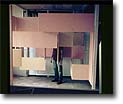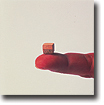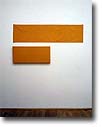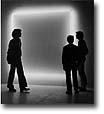Los Angeles County Museum of Art ,
Jun 13, 2004 - Oct 03, 2004
Los Angeles, CA, USA
Beyond Geometry: Experiments in Form 1940's -70's
by Eve Wood
The most amazing work in the show belongs to Eva Hesse, whose piece "C Clamp, Blues (1965)" is an elegant homage both to minimalism, a small plastic ball extends out from the surface of the canvas, and is attached to a precariously balanced C clamp on either side. The canvas is white as is the ball, which gives one the sense of being lost in an mélange of dirty space, floating there endlessly. Hesse's other work in the show is entitle,
"Constant (1967)." Once again the canvas sports odd shoelace-like
protrusions, which are actually pieces of rubber tubings poking out of the wood panel. Once again, the absence of color is central to the power of the piece, the "constant" black like an endlessly tormenting dream, each small protrusion, knotted and hanging on the black and dismal facade gives this piece its resonance. Pol Bury, a Belgian artist is represented by a playful and beautifully rendered sculptural work entitled "Untitled, (1967)". This piece embodies the essence of what this show is all about: wit, economy,
precision, and innovation incorporated into a wall sculptural made of a dozen or so wooden balls attached with strings and moving imperceptivity backwards and forwards on a shelf. The work is seductive in its use of materials, and like other successful works in this show, entices the viewer with a subtle wit. Bruce Naumen's video work "Walk With Contrapposto, 1968" is also darkly humorous, Naumen having constructed a causeway in his studio down which he walks the outlandish, exaggerated ambling gait of an absurd,
deranged ballerina. The word contrapposto means literally "the position of a figure in sculpture and painting in which the hips and legs are turned in a different direction from that of the shoulders and head." Naumen exaggerates the gesture and the narrowness of the corridor only makes it all the more funny, as Naumen maneuvers his body against the two walls like a drunken
clown trying to reclaim himself. The video was shot in black and white and has the grainy appeal of a home movie. Poland was resented by Stansislaw Drozdz' work "Miedzy (between), 1977." On the walls, floor, and ceiling of a room of exactly prescribed dimensions, the letters of the word are arranged
following a precise system. The viewer is literally "between" the obvious graphic nature of the letters and their meaning. This tension "between" the black letters and the surrounding white space is eerie and unsettling, the effects of the scattered letters so precisely arranged like some extraordinary eye exam in heaven, is nearly a spiritual experience, if not a psychic, physical, and most definitely optical masterpiece.
Reclamation is never an easy task, especially when it involves artistic vision, political and sociological concerns. This exhibition examines the role of radically simplified form and systematized strategies in the evolution of vanguard art across the west in the decades following World War II. Covering Central and Western Europe and North and South America, Beyond Geometry is the first exhibition to treat these issues art-historically, in
a broad international context as well as to allow for the emotionalism inherent in many of the works to ring true. No, reclamation is never an easy task, and this exhibition takes extraordinary risks in presenting difficult and sometimes painful work that doesn't necessarily "want" to be loved, but seen, talked about and ultimately absorbed into the collective psyche.
|













